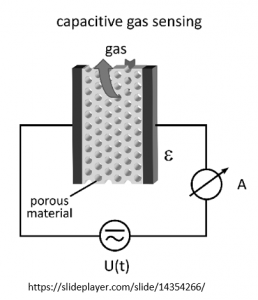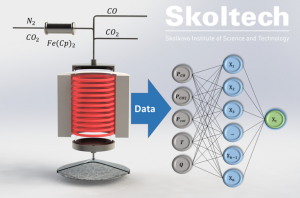Prof. Albert Nasibulin
If you are interested to complete MSc Projects on the mentioned below topics – please, contact Prof. Albert Nasibulin (; nanonasibulin.com)
Background:
Indium tin oxide (ITO) is a leading transparent conductor that is essential for building flat panel displays and touch sensors.
The commercial ITO films on glass are sheet resistance 36 Ω/□ (T=90%, at 550 nm). However, the conductivity of ITO dramatically degrades after bending, which limits its application in flexible electronics.
Single-walled carbon nanotubes (SWCNT) networks have been demonstrated potential advantages in performance and cost reduction in comparison with ITO. Furthermore, high flexibility and stretchability of the SWCNT films open avenues beyond the ITO, i.e. allow to create completely new components in flexible and stretchable transparent electronics.
SWCNT films open avenues beyond the ITO, i.e. allow to create completely new components in flexible and stretchable transparent electronics.
However, to replace the ITO, the optoelectronic properties of the SWCNT films must be still improved. This could be realized by adsorption doping approach.
In our laboratory, using adsorption doping of SWCNT films with gold compounds has allowed us to achieve a record value of the sheet resistance of 31 Ω/sq at T=90%.
Work is currently underway to find new, more efficient, and cheaper p- and n –type dopants to improve the equivalent sheet resistance of the SWCNT films.
Learning Outcome:
You will learn various aspects of nanotubesэ doping with organic and inorganic compounds, measurements of optoelectronic properties of films, interact with groups, generate reports, present the results at regular group meetings and conferences.
Background:
It has been over a decade since the intrinsic photoluminescence (PL) of semiconducting single-walled carbon nanotubes (SWCNTs) in aqueous media was discovered. Originating from the relaxation of the excitonic pairs, this remarkable property of individual SWCNTs brought up their various applications: from fiber optics to biomedical imaging and single-molecule sensing.
However, macroscopic samples of SWCNTs possess extremely low fluorescence efficiencies (<0.1%), attributed to the presence of non-emissive metallic nanotubes and residual bundles. To observe photoluminescence from SWCNT in aqueous solutions, an exhaustive pre-treatment, including individualization of nanotubes by various surfactants and separation of semiconducting species, is required. For the fine-tuning of PL, various functionalization of nanotubes’ surface is performed.
Biological applications of SWCNT imply that the fluorescence must be emitted in the second near-infrared (NIR II) spectrum region from 1000 to 1400 nm since little to no autofluorescence from biological tissues is registered there.
There are several approaches to enhance the fluorescence of carbon nanotubes. The most straightforward is the exfoliation of individual nanotubes from bundles with subsequent separation nanotubes by chirality.
Another way to achieve intensive fluorescence signal is the chemical functionalization of SWCNTs’ surface by 1. shielding coatings formation; 2. covalent functionalization with diazonium compounds via Meerwein’s reaction.
Learning Outcome:
You will learn different chemical approaches of SWCNT functionalization and chirality separation including size-exclusive chromatography, measurements of PL, interact with different groups, generate reports, present the results at regular group meetings and conferences as well as participating in writing articles.
Background:
Single-walled carbon nanotubes (SWCNTs) and boron nitride nanotubes (BNNTs) attract a constantly growing attention due to their unique physical and chemical properties. BNNTs are the closest structural analog of carbon nanotubes, where half of the carbon atoms are substituted with boron and the other half with nitrogen atoms.
However, their electronic properties are directly opposite. SWCNTs exhibit either metallic or semiconductor behavior depending on their chiral indices (m, n), whereas boron nitride nanotubes are essentially electrical insulators, regardless of their chirality.
Free-standing SWCNTs possess unique properties and can be applied in many novel applications like thermoacoustic generators, resistively heating aerosol filters, and gas heaters, where in addition to the film conductivity a temperature resistance of the material comes into the picture. Meanwhile, BNNTs feature excellent shielding capability and pronounced oxidation resistance up to 900 °C.
For complete shielding of free-standing SWCNTs and preservation of their intrinsic properties, the optimal approach is the synthesis of BN atomic layers, which are coaxially stacked on the surface of SWCNTs to form a 1D van der Waals (1D vdW ) SWCNT-BNNT heterostructure.
Learning Outcome:
You will learn how to synthesize and characterize 1D van der Waals heterostructures, and study the mechanism of their formation. You will learn how to interact with various groups, generate reports, present results at regular group meetings and conferences.
Background: the electronic nose is a type of gas analytical device which can selectively identify gas admixture in the environment. Usually, it is made when several non-specific sensors are collected in array those vector signal represents “fingerprint” of a specific gas to be determined with the use of pattern recognition algorithms [1]. In this way, it mimics the olfactory system of mammalians. A great number of gas admixtures requires extensive training. Within this study, we will couple a gas chromatography column with an electronic nose to reduce the training routine due to the appearance of known (anticipated number) analytes to be separated by the column [2].
Learning outcome: We will learn how to develop an electronic nose, how to couple the devices; develop machine learning protocols to selectively determine gas mixture and develop new sensitive materials for the electronic nose.
References:
[1] Persaud, K. & Dodd, G. Analysis of discrimination mechanisms in the mammalian olfactory system using a model nose. Nature 299, 352–355 (1982). [2] van den Broek, J., Abegg, S., Pratsinis, S. E. & Güntner, A. T. Highly selective detection of methanol over ethanol by a handheld gas sensor. Nat. Commun. 10, 4220 (2019).Background: while the electronic nose can selectively identify gas admixtures in the environment, it is trained to a “fingerprint” of a specific gas to be determined [1]. Thus, it is a rather flexible device that can be trained to determine many gases. However, it might miss-evaluate unknown ad-mixtures, i.e. the compounds which were not used for calibration or training, or mixtures of several volatile compounds. We propose to develop machine learning algorithms combined with the development of new sensitive materials to specifically determine the composition of complex mixtures.
Learning outcome: we will learn how the gas analytical system operates, develop new sensitive materials and protocols for their realization on a gas analytical chip; machine learning protocols are going to be developed.
References:
[1] Persaud, K. & Dodd, G. Analysis of discrimination mechanisms in the mammalian olfactory system using a model nose. Nature 299, 352–355 (1982).Background: While the market is dominated by 3 types of sensors, i.e. optical, electrochemical, and metal oxide semiconductor, where the semiconductor ones rely mostly on the change in resistance when analyte appears (chemiresistive), chemicapacitive sensors might be rather promising [1]. Usually, they require the application of porous materials whose capacitance changes greatly by adsorption of gas admixtures [2]. The development of such sensors might call for new porous materials to be synthesized, i.e. single-walled carbon nanotubes.
Learning outcome: we will learn how to develop materials for chemicapacitive sensors, sensor architecture, and machine learning tools to improve its selectivity.
References:
[1] E. Mounier, B. Roussel, Gas and Particle Sensors 2018, Market & Technology Report, Yole Development, November 2018, (2018) https://www.i-micronews.com/products/gas-and-particle-sensors-2018/. [2] M. N. Kavalenka et al. Chemical capacitive sensing using ultrathin flexible nanoporous electrodes. Sensors Actuators B Chem. 162, 22-26 (2012).Background: materials like single-walled carbon nanotubes show a remarkable perspective for various electrochemical applications [1]. On one hand, encapsulated catalytic particles protected by carbon shell might facilitate hydrogen evolution reaction at the level comparable with commercial Pt/C catalysts, one the other, functionalization of carbon nanotubes might favor other electrocatalytic processes, like OER [2] while carbon nanotube networks serve as a perfect substrate characterized by high surface area and excellent conductivity. Though, there is a demand for new approaches to carbon nanotube functionalization which would allow tuning their catalytic performance. We propose the development of new catalysts based on functionalized single-walled carbon nanotubes for application in electrocatalysis.
Learning outcome: we will learn how to handle free-standing single-walled carbon nanotube films and how to functionalize these films to tailor the best electrocatalytic performance.
References:
[1] Tavakkoli M. et al. Angew. Chem. Int. Ed. 54, 4535–4538 (2015). [2] Davodi F., Tavakkoli M., Lahtinen J. and Kallio T. J. Catal. 353, 19–27 (2017).Advisors: Yuriy Gladush, Daria Kopylova, Albert Nasibulin
Bolometer is a type of photodetector that changes the electrical resistance when heated up by the absorbed radiation. Bolometers are widely used in infrared spectral region but the spectral information is lost in this type of measurement. In the project we will implement an “Infrared vision” – a detector with spectral sensitivity inspired by the human eye color perception mechanism. For this we will make the device with carbon nanotubes or graphene as a bolometric sensor and a photonic crystal an array as spectrally sensitive elements. By applying machine learning methods to the signal from an array of sensors with different spectral response it is possible to retrieve the spectrum of the incident radiation.
Learning outcomes: you will get insights in the modern areas of science – physics of low dimensional materials, photodetector principles of operation, plasmonics and physics of photonic crystals. You will participate in all steps of research starting from sample fabrication with electron and optical lithography, photonic crystal spectral properties measurements and determination of detector photoresponce. If you are also interested in machine learning, this is an excellent opportunity to train your skills on a real life physical problem.
[1] Kopylova et al. Holey Single-Walled Carbon Nanotubes for Ultra-Fast Broadband Bolometers, Nanoscale, 10 (2018), 18665. [2] Wang, Z., Yi, S., Chen, A. et al. Single-shot on-chip spectral sensors based on photonic crystal slabs. Nat Commun 10, 1020 (2019).Background
Bolometers are type of infrared photodetector, whose operating principle is based on the change in resistance of a material heating up under irradiation. The sensitivity of bolometers strongly depends on temperature coefficient of resistance, TCR (dR/RdT) of the sensor material, while operation speed depends on heat capacity of sensor area. Single-walled carbon nanotubes (SWCNT) films are perspective material for this application due to extremely low heat capacity of thin film (~20nm). On the other hand the TCR of pristine tubes is small comparing to industry standard vanadium oxides.
The goal of the project is to improve the properties of the SWCNT bolometers by rational design oа sensor material. One of the approaches lies in treatment of tubes in different plasmas (oxygen, hydrogen etc.), which significantly increases TCR of the tubes [1]. Other approach includes incorporation nanotubes into vanadium oxides nanostructures, where SWCNTs work as absorber and oxides as a conductor.
Learning outcome
During implementation of the project you will learn different approaches of nanomaterials treatment, working with plasma, as well as with different techniques of SWCNT characterisation: FTIR, SEM, TEM and Raman, bolometers properties characterization, noise theory and measurement. You will interact with different groups, generate reports, present the results at regular group meetings and conferences as well as participating in writing articles.
References
- Kopylova et al. Holey Single-Walled Carbon Nanotubes for Ultra-Fast Broadband Bolometers, Nanoscale, 10 (2018), 18665.
Supervisors: Prof. Albert Nasibulin (; nanonasibulin.com), Dr. Dmitry Krasnikov (; faculty.skoltech.ru/people/dmitrykrasnikov)
Background:
Recently synthesized layered metal-organic frameworks (MOFs) as well as single-layer counterparts (2D MOFs) were demonstrated to exhibit physical properties similar to inorganic crystals, such as band conductivity, ferromagnetism, and even superconductivity. Owing to relatively high chemical stability, layered MOFs, as well as single-layer 2D counterparts, are promising in thin-film electronics, gas sensing, catalysis, etc. However, the data acquired on layered MOFs is to be extensively developed to reveal general trends of this brand-new field.
Aim:
This work aims to investigate the general optoelectronic properties of novel layered metal-organic frameworks. Using a systematic set of structural, electrical, and optical methods, we successfully synthesized layered MOFs with benzenehexathiol (BHT) as a linker and six metal ions, namely Cr, Mn, Co, Fe, Ni, Cu.
Learning outcomes:
You will become a specialist in a wide range of methods:
- Electrical measurements,
- THz time-domain spectroscopy
- UV-vis-NIR spectroscopy
- X-ray photoelectron spectroscopy
- MOF synthesis and processing
- AFM/STM studies.
Project experience, international collaborations.
Supervisors: Prof. Albert Nasibulin (; nanonasibulin.com), Dr. Dmitry Krasnikov (; faculty.skoltech.ru/people/dmitrykrasnikov)
Background:
Synthesis of carbon nanotubes with tailored characteristics is a holy grail of nanotechnology for the last couple decades. However, the complexity of mechanisms for the nanotube nucleation, growth and termination inhibited the progress towards the control of the product with defined parameters. The lack of the general model and systematic datasets are still the key barriers for the controlled synthesis and therefore for a wide range of applications. We have gathered a relatively (when compared to carbon nanotube field) large database describing SWCNT synthesis.
https://doi.org/10.1016/j.carbon.2019.07.013
https://doi.org/10.1021/acs.jpclett.9b02777
Aim:
To develop a predictive model and provide sensitivity analysis in order to couple the black box with physico-chemical models
Learning outcomes:
Project experience, international collaborations, high-impact articles.